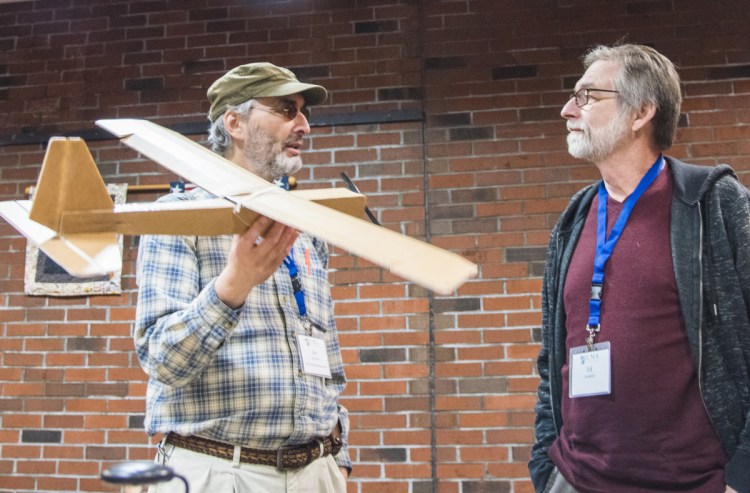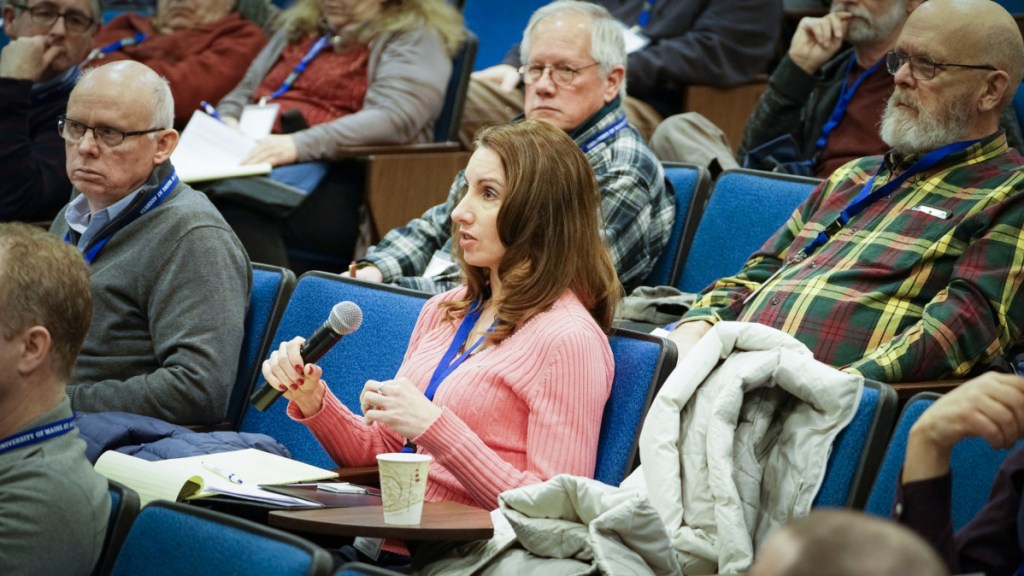AUGUSTA — One brief statement in David Price’s presentation Saturday morning sums up the state of commercial drones today.
“I fly drones most every day. I don’t go more than 10 days without thinking up a new business application,” Price said.
The possibilities are vast and expanding.
During his presentation, which kicked off a daylong conference at the University of Maine at Augusta on the use of commercial drones for business, Price rattled off some of the possibilities for using drones to gather information easily and quickly through remote sensing that otherwise might be too dangerous or time-consuming for anyone to do.
Price’s assessment is backed up by industry research. The Association for Unmanned Vehicle Systems International projected in 2013 that as many as 100,000 new jobs would be created in the industry nationwide between 2015 and 2025. In Maine, that number was projected to be 810, with an economic impact during that same period of $641 million.
Using these small aircraft that are piloted remotely — they are sometimes also referred to as unmanned aerial vehicles — for commercial purposes has become legal only recently.
Daniel Leclair, director for education and research for unmanned aircraft systems at UMA, said the Federal Aviation Administration released its rules on the commercial operation of drones on Aug. 29, 2016. UMA launched its first class less than two months later. That’s a fast turnaround for an academic organization, he said. The college has trained 125 pilots in a year.
The rules spell out who can operate commercial drones and how they ought to be operated. They are restricted to flying during daylight hours only, and they must be operated within the line of sight of the operator. They are not allowed to operate over people not involved in the operation they are being flown for, and they can’t travel faster than 100 mph or higher than 400 feet above ground level.
However, Price pointed out, pilots may seek waivers from the FAA in some circumstances.

David Price, of the Association of Professional Drone Pilots, holds a drone Saturday while speaking at the first drone business applications conference at the University of Maine in Augusta.
Even with the restrictions, the applications for drone use by public and private organizations are broad. In the wake of the storm in late October that triggered a massive power outage across Maine, Sara Burns, then-president and chief executive officer of Central Maine Power Co., said her company was using drones as part of its assessment of power lines and poles across its service territory.
Price’s presentation included a short video, captured by a drone, of a fire crew fighting a large building fire. The video showed in real time that the high water pressure of the hoses deployed on the building’s front was knocking bricks onto the people who were fighting the fire from behind the building.
In Maine, the state police have used drones to capture images and aerial views of crashes, including at the 2017 double-fatal motorcycle crash during the Toy Run on Interstate 95, said Steve McCausland, spokesman for the Maine Department of Public Safety.
The Augusta Police Department does not use drones currently.
“We are still waiting for rules and polices to come out so we can utilize them,” Deputy Chief Jared Mills said Saturday. “Until then, we will not look to purchase any.”
Price, who is a former professor and dean of aviation sciences at Bridgewater State University in Bridgewater, Massachusetts, said drones can carry different kinds of cameras for different applications. A ski resort in western Massachusetts uses a drone with heat-sensing technology to guide its snow-making operation.
“We’re using drones for 3-D jobs,” he said. “They’re either dull, dangerous or dirty.”
Using drones for tasks such as inspecting bridges and wind turbines or measuring the amount of snow on rooftops makes those jobs far less risky.
The conference, Drone Applications for Business: Navigating Your Airspace, debuted Saturday, drawing about 75 people from the curious to the expert from across New England and Washington, D.C. to hear about the regulatory landscape, insurance and liability considerations; and to take part in a range of workshops on using drones in agriculture, surveying, the utility industry and in emergency situations and as a method of helping those with disabilities explore the world.
Leclair said this business sector is in its infancy and the drone program at UMA is its fastest-growing program.
“It’s like the wild, wild West,” he said.
Jessica Lowell — 621-5632
Twitter: @JLowellKJ
Copy the Story LinkSend questions/comments to the editors.




Success. Please wait for the page to reload. If the page does not reload within 5 seconds, please refresh the page.
Enter your email and password to access comments.
Hi, to comment on stories you must . This profile is in addition to your subscription and website login.
Already have a commenting profile? .
Invalid username/password.
Please check your email to confirm and complete your registration.
Only subscribers are eligible to post comments. Please subscribe or login first for digital access. Here’s why.
Use the form below to reset your password. When you've submitted your account email, we will send an email with a reset code.